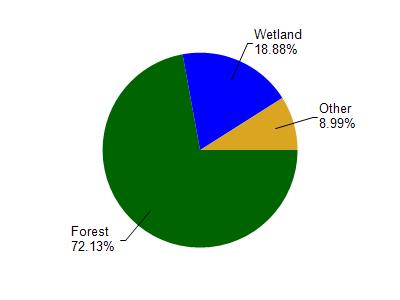Forest
No
No
No
Fish and Aquatic Life
Overview
Roberts Lake, in the Lily River Watershed, is a 435.06 acre lake that falls in Forest County. This lake is managed for fishing and swimming and is currently not considered impaired.
Date 2011
Author Aquatic Biologist
Historical Description
Source: 1977, Surface Water Resources of Forest County Roberts Lake, T34N, R14E, Sec. 6 Surface Acres = 452, Maximum depth = 32 feet, Secchi disk = 7 feet.
A hard water spring lake having alkaline, clear water of moderate transparency. The two inlets are drainage from three small spring ponds and the outlet forms the headwaters of the Lily River and flows to Lily Lake. The shoreline is predominantly upland (99 percent) consisting of hardwoods and conifer with the remainder being a meadow and shrub wetland. Composition of the Littoral material is boulders (30 percent), rubble (20 percent), gravel (20 percent), sand (15 percent), muck (10 percent) and silt (5 percent). Fish inhabiting this lake include largemouth bass, walleye, muskellunge, perch, bluegill, black crappie, rock bass and pumpkinseed. The lake supports a dense growth of aquatic vegetation adjacent to the shoreline. An improved boat landing with parking is located on the southeast shore. Shoreline developments include 82 dwellings and four resorts. A water control structure having a head of 1 foot is located at the outlet. Muskrat and loon make use of this lake. Of the 5.06 miles of shoreline, 0.06 miles is public frontage.
Date 1977
Author Surface Water Inventory Of Wisconsin
Condition
Wisconsin has over 84,000 miles of streams, 15,000 lakes and milllions of acres of wetlands. Assessing the condition of this vast amount of water is challenging. The state's water monitoring program uses a media-based, cross-program approach to analyze water condition. An updated monitoring strategy (2015-2020) is now available. Compliance with Clean Water Act fishable, swimmable standards are located in the Executive Summary of Water Condition in 2018. See also the 'monitoring and projects' tab.
Reports
Management Goals
Wisconsin's Water Quality Standards provide qualitative and quantitative goals for waters that are protective of Fishable, Swimmable conditions [Learn more]. Waters that do not meet water quality standards are considered impaired and restoration actions are planned and carried out until the water is once again fishable and swimmable
Management goals can include creation or implementation of a Total Maximum Daily Load analysis, a Nine Key Element Plan, or other restoration work, education and outreach and more. If specific recommendations exist for this water, they will be displayed below online.
Monitoring
Monitoring the condition of a river, stream, or lake includes gathering physical, chemical, biological, and habitat data. Comprehensive studies often gather all these parameters in great detail, while lighter assessment events will involve sampling physical, chemical and biological data such as macroinvertebrates. Aquatic macroinvertebrates and fish communities integrate watershed or catchment condition, providing great insight into overall ecosystem health. Chemical and habitat parameters tell researchers more about human induced problems including contaminated runoff, point source dischargers, or habitat issues that foster or limit the potential of aquatic communities to thrive in a given area. Wisconsin's Water Monitoring Strategy was recenty updated.
Grants and Management Projects
Monitoring Projects
| WBIC | Official Waterbody Name | Station ID | Station Name | Earliest Fieldwork Date | Latest Fieldwork Date | View Station | View Data |
|---|
| 378400 | Roberts Lake | 213132 | Roberts Lake - Deep Hole | 5/11/1995 | 9/1/2025 | Map | Data |
| 378400 | Roberts Lake | 10002565 | Roberts Lake | 7/27/1999 | 6/16/2025 | Map | Data |
| 378400 | Roberts Lake | 10019037 | Roberts Lake -- Access | 7/15/2007 | 5/31/2024 | Map | Data |
|

Watershed Characteristics
Roberts Lake is located in the Lily River watershed which is 209.47 mi². Land use in the watershed is primarily forest (72.20%), wetland (18.90%) and a mix of open (4.20%) and other uses (4.80%). This watershed has 161.31 stream miles, 4,248.79 lake acres and 18,178.21 wetland acres.
Nonpoint Source Characteristics
This watershed is ranked Not Ranked for runoff impacts on streams, Not Ranked for runoff impacts on lakes and Low for runoff impacts on groundwater and therefore has an overall rank of Low. This value can be used in ranking the watershed or individual waterbodies for grant funding under state and county programs.However, all waters are affected by diffuse pollutant sources regardless of initial water quality. Applications for specific runoff projects under state or county grant programs may be pursued. For more information, go to surface water program grants.